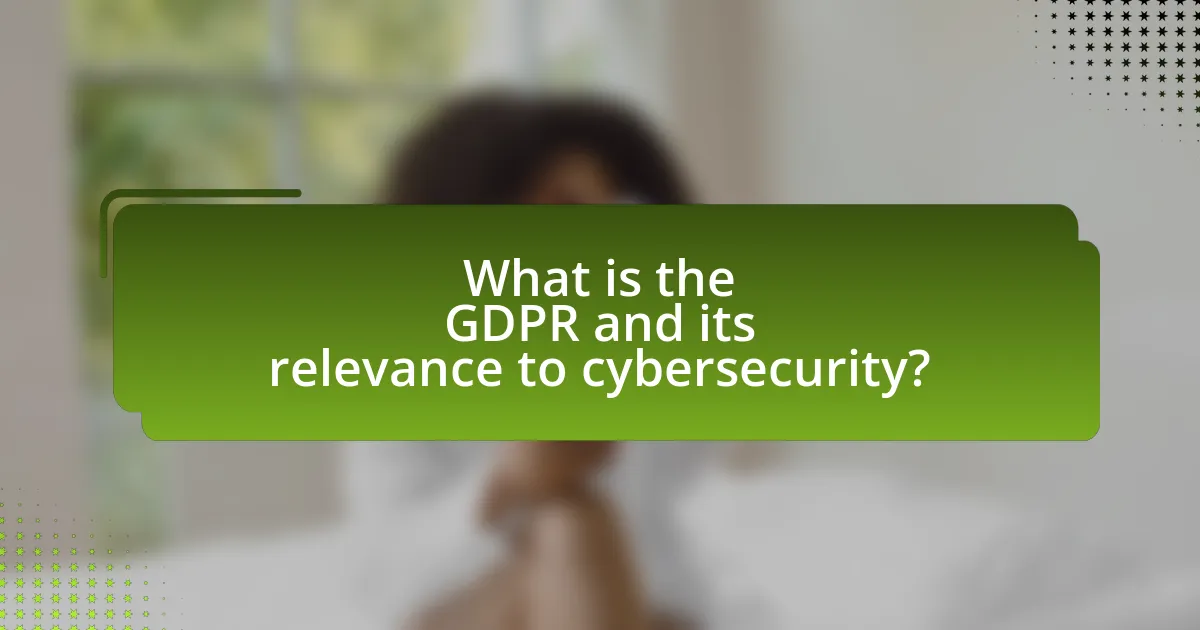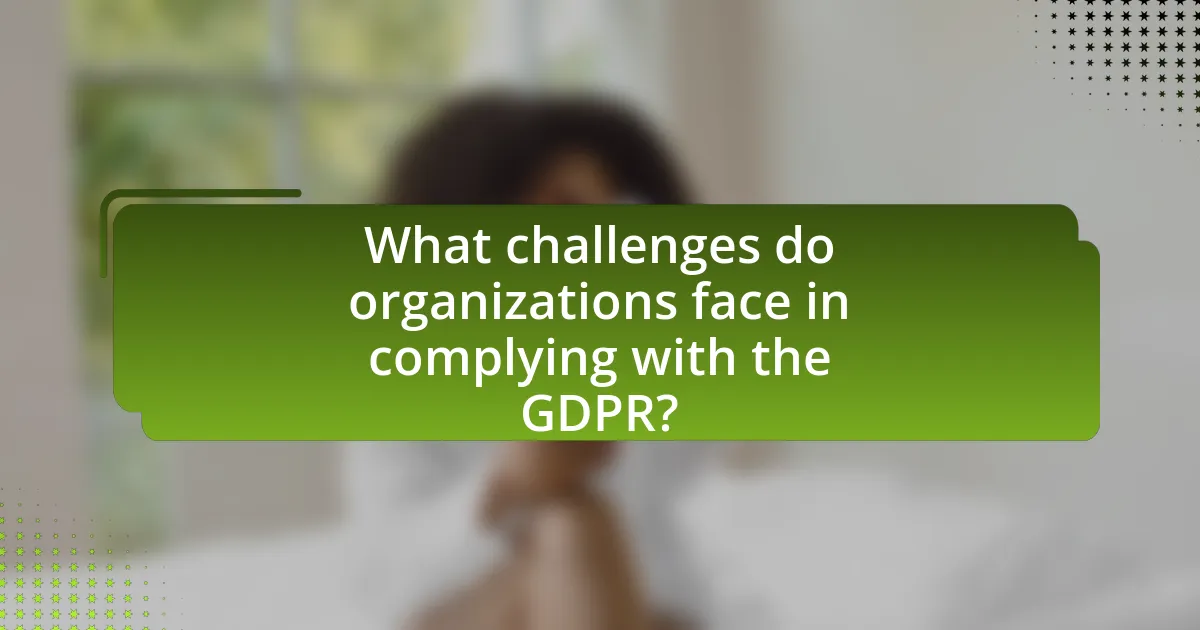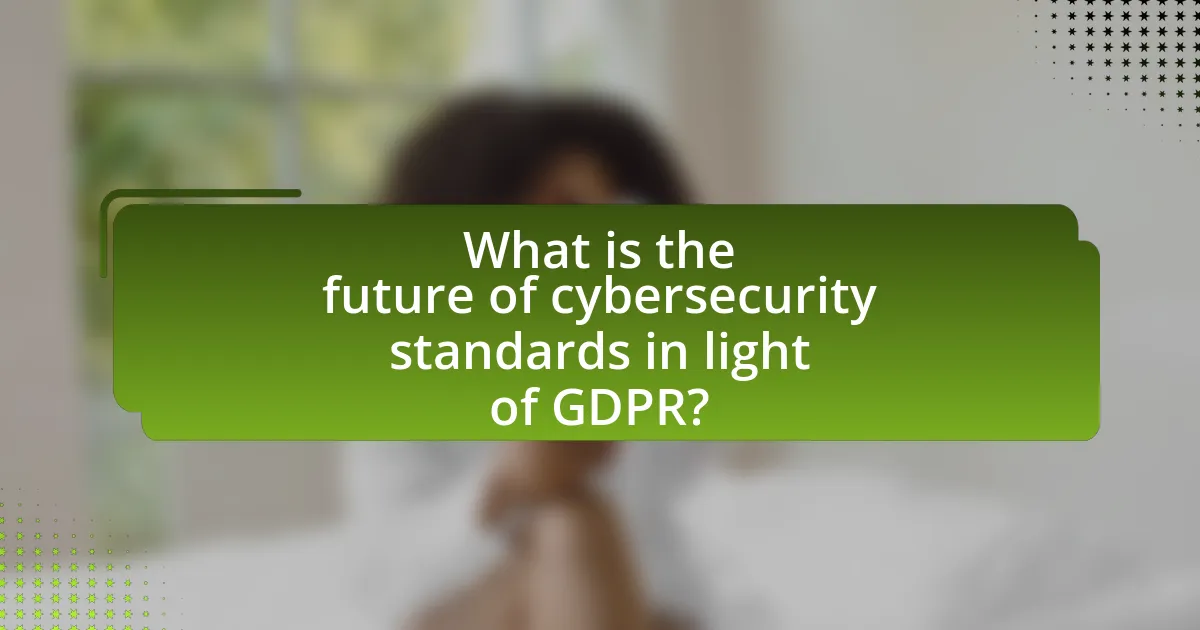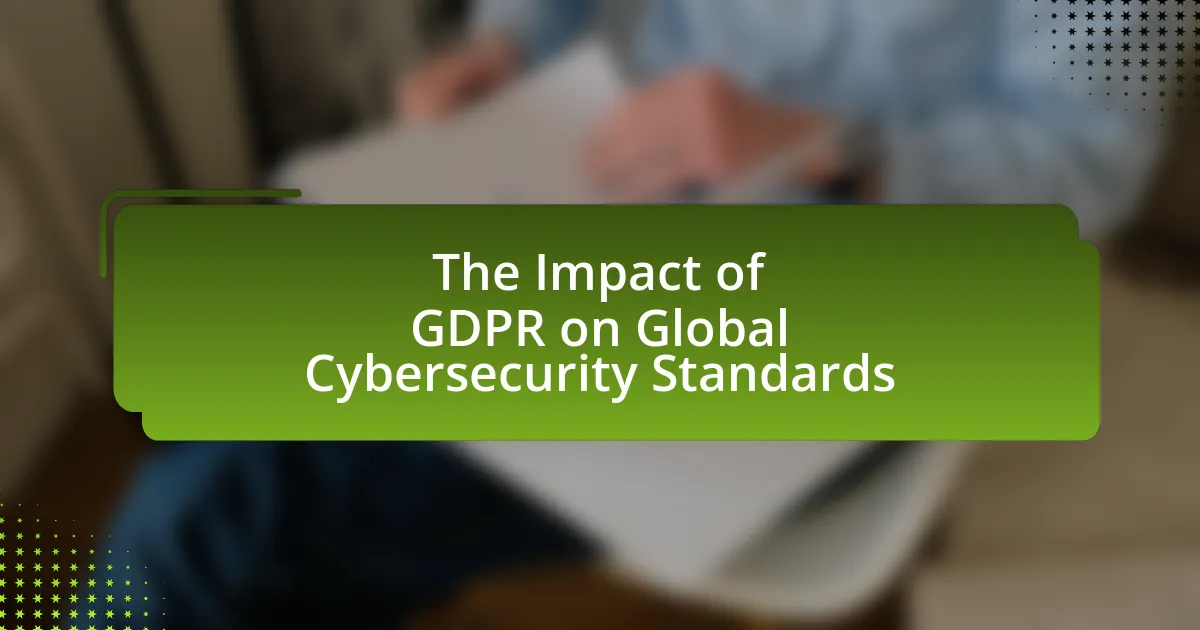The General Data Protection Regulation (GDPR) is a pivotal data protection law established by the European Union in May 2018, significantly influencing global cybersecurity standards. This article examines the GDPR’s stringent requirements for data protection, including the definition of personal data, the principles of accountability and data minimization, and the implications for organizations, particularly those outside the EU. It also addresses the challenges of compliance, common misconceptions, and the evolving landscape of cybersecurity in response to GDPR, highlighting the necessity for robust data protection measures and the potential penalties for non-compliance. The discussion underscores the regulation’s role in shaping international data protection frameworks and its impact on future cybersecurity practices.

What is the GDPR and its relevance to cybersecurity?
The General Data Protection Regulation (GDPR) is a comprehensive data protection law enacted by the European Union in May 2018, aimed at enhancing individuals’ control over their personal data. Its relevance to cybersecurity lies in its stringent requirements for data protection measures, mandating organizations to implement appropriate technical and organizational safeguards to protect personal data from breaches. For instance, GDPR requires data breach notifications within 72 hours, emphasizing the need for robust cybersecurity practices to comply with legal obligations and avoid significant fines, which can reach up to 4% of annual global turnover or €20 million, whichever is higher. This regulatory framework has influenced global cybersecurity standards by promoting a culture of accountability and transparency in data handling practices.
How does the GDPR define personal data and its protection?
The General Data Protection Regulation (GDPR) defines personal data as any information relating to an identified or identifiable natural person, known as the data subject. This includes names, identification numbers, location data, and online identifiers, among other identifiers that can directly or indirectly identify an individual. The GDPR mandates that personal data must be processed lawfully, transparently, and for specific purposes, ensuring that individuals have rights over their data, including access, rectification, and erasure. The regulation also requires organizations to implement appropriate technical and organizational measures to protect personal data against unauthorized access, loss, or damage, thereby reinforcing the importance of data protection in the digital age.
What types of data are considered personal under the GDPR?
Personal data under the GDPR includes any information that relates to an identified or identifiable natural person. This encompasses a wide range of data types, such as names, identification numbers, location data, online identifiers, and specific characteristics that can identify an individual, either directly or indirectly. The GDPR defines personal data broadly to ensure comprehensive protection, reflecting the need to safeguard individuals’ privacy in various contexts, including digital environments.
Why is the protection of personal data crucial in cybersecurity?
The protection of personal data is crucial in cybersecurity because it safeguards individuals’ privacy and prevents unauthorized access to sensitive information. When personal data is compromised, it can lead to identity theft, financial loss, and reputational damage for individuals and organizations. According to a report by IBM, the average cost of a data breach in 2021 was $4.24 million, highlighting the financial implications of inadequate data protection. Furthermore, regulations like the General Data Protection Regulation (GDPR) enforce strict guidelines on data handling, emphasizing the importance of protecting personal data to maintain compliance and avoid hefty fines. This regulatory framework not only enhances individual privacy but also strengthens overall cybersecurity measures by promoting best practices in data management.
What are the key principles of the GDPR that impact cybersecurity?
The key principles of the GDPR that impact cybersecurity include data protection by design and by default, accountability, and the requirement for data breach notifications. Data protection by design mandates that organizations integrate data protection measures into their systems and processes from the outset, thereby enhancing cybersecurity. The principle of accountability requires organizations to demonstrate compliance with GDPR, which includes implementing appropriate security measures to protect personal data. Additionally, the GDPR stipulates that organizations must notify authorities and affected individuals of data breaches within 72 hours, emphasizing the importance of rapid response and effective incident management in cybersecurity practices. These principles collectively aim to strengthen the security of personal data and mitigate risks associated with data breaches.
How do the principles of data minimization and purpose limitation affect data handling?
The principles of data minimization and purpose limitation significantly affect data handling by ensuring that organizations only collect and process personal data that is necessary for specific, legitimate purposes. Data minimization mandates that only the minimum amount of data required for a given purpose should be collected, reducing the risk of unnecessary exposure and misuse of personal information. Purpose limitation requires that data collected for one purpose cannot be used for another unrelated purpose, thereby enhancing accountability and transparency in data processing activities. These principles are foundational to the General Data Protection Regulation (GDPR), which enforces strict compliance measures, leading organizations to adopt more stringent data governance practices and ultimately improving overall data security.
What role does accountability play in GDPR compliance for organizations?
Accountability is a fundamental principle of GDPR compliance for organizations, requiring them to demonstrate responsibility for personal data processing activities. This principle mandates that organizations not only comply with GDPR regulations but also actively show how they implement data protection measures, such as conducting Data Protection Impact Assessments and maintaining records of processing activities. The European Data Protection Board emphasizes that accountability involves both proactive measures and the ability to provide evidence of compliance, which can include audits and documentation. This structured approach ensures that organizations are held responsible for their data handling practices, thereby enhancing trust and security in the digital environment.
How does the GDPR influence global cybersecurity standards?
The General Data Protection Regulation (GDPR) significantly influences global cybersecurity standards by establishing stringent data protection requirements that organizations must follow. This regulation compels companies worldwide to adopt robust cybersecurity measures to ensure the privacy and security of personal data, as non-compliance can result in substantial fines, reaching up to 4% of annual global turnover or €20 million, whichever is higher. Consequently, businesses outside the European Union are increasingly aligning their cybersecurity practices with GDPR principles to maintain market access and protect consumer trust. This shift has led to the development of more comprehensive cybersecurity frameworks globally, as organizations recognize the need to enhance their data protection strategies in response to GDPR’s rigorous standards.
What are the implications of GDPR compliance for non-EU companies?
GDPR compliance for non-EU companies means they must adhere to strict data protection regulations when processing the personal data of EU citizens. This requirement arises because GDPR applies to any organization, regardless of location, that handles the data of individuals within the EU. Non-EU companies face potential fines of up to €20 million or 4% of their global annual revenue for non-compliance, which underscores the financial risks involved. Additionally, these companies must implement robust data protection measures, conduct impact assessments, and appoint data protection officers if their processing activities warrant it. The implications extend to increased operational costs and the need for enhanced cybersecurity practices to meet GDPR standards, thereby influencing global cybersecurity norms.
How has GDPR shaped international data protection regulations?
GDPR has significantly influenced international data protection regulations by establishing a comprehensive framework that prioritizes user consent and data privacy. This regulation has prompted countries outside the European Union to adopt similar laws, such as Brazil’s General Data Protection Law (LGPD) and California’s Consumer Privacy Act (CCPA), which reflect GDPR’s principles of transparency, accountability, and individual rights. The global reach of GDPR, which applies to any entity processing the data of EU citizens, has led to a harmonization of data protection standards, encouraging nations to enhance their legal frameworks to ensure compliance and protect citizens’ privacy rights.

What challenges do organizations face in complying with the GDPR?
Organizations face several challenges in complying with the GDPR, including the complexity of the regulation, the need for significant changes to data management practices, and the requirement for ongoing employee training. The GDPR’s intricate legal language and broad scope can create confusion regarding compliance obligations, making it difficult for organizations to interpret and implement necessary measures. Additionally, organizations often need to overhaul existing data processing systems and policies to align with GDPR requirements, which can be resource-intensive and costly. Furthermore, ensuring that all employees understand their roles in data protection necessitates continuous training and awareness programs, adding another layer of complexity to compliance efforts. These challenges are compounded by the potential for substantial fines, which can reach up to 4% of annual global turnover or €20 million, whichever is higher, creating a pressing need for organizations to prioritize compliance.
What are the common misconceptions about GDPR compliance?
Common misconceptions about GDPR compliance include the belief that it only applies to companies within the European Union, that it is solely about data protection, and that compliance is a one-time effort. GDPR applies to any organization processing the personal data of EU residents, regardless of the organization’s location, which means global companies must comply. Additionally, while data protection is a significant aspect, GDPR also emphasizes data privacy rights, requiring organizations to implement comprehensive measures that address both. Lastly, compliance is an ongoing process that involves continuous monitoring and updates to policies and practices, not just a one-time checklist.
How can organizations effectively address these misconceptions?
Organizations can effectively address misconceptions about GDPR by implementing comprehensive training programs for employees and stakeholders. These programs should focus on clarifying the specific requirements of GDPR, such as data protection principles and individual rights, which are often misunderstood. For instance, a study by the European Commission in 2020 indicated that 60% of businesses lacked a clear understanding of GDPR obligations, highlighting the need for targeted education. Additionally, organizations should develop clear communication strategies that provide accurate information about GDPR’s implications for cybersecurity practices, ensuring that all parties involved are informed and aligned. By fostering a culture of transparency and continuous learning, organizations can mitigate misconceptions and enhance compliance with GDPR standards.
What are the potential penalties for non-compliance with the GDPR?
The potential penalties for non-compliance with the GDPR can reach up to €20 million or 4% of the annual global turnover, whichever is higher. This regulation establishes strict financial repercussions to ensure adherence to data protection standards. For instance, in 2021, Amazon was fined €746 million by Luxembourg’s data protection authority for violations related to GDPR, illustrating the significant financial risks associated with non-compliance.
How can organizations enhance their cybersecurity measures to align with GDPR?
Organizations can enhance their cybersecurity measures to align with GDPR by implementing robust data protection strategies, including encryption, access controls, and regular security assessments. These measures ensure that personal data is processed securely and that organizations can demonstrate compliance with GDPR requirements. For instance, encryption protects data at rest and in transit, reducing the risk of unauthorized access. Access controls limit data access to authorized personnel only, minimizing potential breaches. Regular security assessments help identify vulnerabilities and ensure that security measures are effective, as highlighted by the European Data Protection Board’s guidelines on data protection by design and by default.
What best practices should organizations implement for data protection?
Organizations should implement encryption, access controls, regular audits, and employee training as best practices for data protection. Encryption secures sensitive data both at rest and in transit, making it unreadable to unauthorized users. Access controls limit data access to authorized personnel only, reducing the risk of data breaches. Regular audits help identify vulnerabilities and ensure compliance with regulations like GDPR, which mandates strict data protection measures. Employee training raises awareness about data security risks and promotes best practices among staff, significantly reducing the likelihood of human error leading to data breaches. These practices collectively enhance an organization’s ability to protect sensitive information and comply with global cybersecurity standards.
How can organizations conduct effective data protection impact assessments?
Organizations can conduct effective data protection impact assessments (DPIAs) by following a structured process that includes identifying the need for a DPIA, describing the information flows, assessing the necessity and proportionality of the processing, identifying and assessing risks, and integrating measures to mitigate those risks. This process is essential under the General Data Protection Regulation (GDPR), which mandates DPIAs for processing activities that are likely to result in a high risk to individuals’ rights and freedoms.
To ensure effectiveness, organizations should engage relevant stakeholders, document the assessment process thoroughly, and review the DPIA regularly to adapt to any changes in processing activities or regulatory requirements. The European Data Protection Board provides guidelines that emphasize the importance of involving data subjects and ensuring transparency throughout the DPIA process.

What is the future of cybersecurity standards in light of GDPR?
The future of cybersecurity standards will increasingly align with GDPR requirements, emphasizing data protection and privacy. As organizations strive to comply with GDPR, they will adopt more stringent cybersecurity measures, including enhanced encryption, access controls, and incident response protocols. The European Data Protection Board has indicated that compliance with GDPR will necessitate a shift towards proactive cybersecurity strategies, which will influence global standards. Additionally, the rise of regulatory frameworks inspired by GDPR, such as the California Consumer Privacy Act, will further drive the harmonization of cybersecurity practices worldwide, ensuring that data protection becomes a fundamental aspect of cybersecurity standards.
How might GDPR evolve to address emerging cybersecurity threats?
GDPR may evolve to address emerging cybersecurity threats by incorporating more stringent requirements for data protection and breach notification. As cyber threats become increasingly sophisticated, the regulation could mandate organizations to implement advanced security measures, such as encryption and regular security assessments, to safeguard personal data. Additionally, GDPR might expand its scope to include specific guidelines for emerging technologies like artificial intelligence and the Internet of Things, ensuring that data privacy is maintained in these contexts. The European Data Protection Board has already indicated a proactive approach to adapting regulations in response to technological advancements, highlighting the need for continuous updates to address evolving risks effectively.
What trends in cybersecurity could influence future GDPR regulations?
Emerging trends in cybersecurity, such as the rise of artificial intelligence (AI) in threat detection, increased focus on data privacy, and the growing prevalence of ransomware attacks, could significantly influence future GDPR regulations. AI technologies enhance the ability to identify and respond to security threats in real-time, prompting regulators to consider how these advancements can be integrated into compliance frameworks. Additionally, as organizations prioritize data privacy in response to consumer demand and regulatory scrutiny, GDPR may evolve to include stricter guidelines on data handling and processing. The surge in ransomware incidents, which often target personal data, may lead to more robust requirements for data breach notifications and incident response protocols within GDPR. These trends indicate a dynamic regulatory landscape that will adapt to the evolving cybersecurity environment.
What practical steps can organizations take to ensure ongoing GDPR compliance?
Organizations can ensure ongoing GDPR compliance by implementing a comprehensive data protection strategy that includes regular audits, employee training, and robust data management practices. Regular audits help identify compliance gaps and ensure that data processing activities align with GDPR requirements. Employee training is essential to raise awareness about data protection principles and responsibilities, as informed staff are crucial for maintaining compliance. Additionally, organizations should establish clear data management practices, including data minimization, secure data storage, and proper consent mechanisms, to protect personal data effectively. These steps are supported by the GDPR’s emphasis on accountability and transparency, which mandates that organizations demonstrate compliance through documented processes and procedures.
How can regular training and awareness programs improve compliance efforts?
Regular training and awareness programs enhance compliance efforts by ensuring that employees understand the regulations and their responsibilities under them. These programs provide essential knowledge about GDPR requirements, which helps mitigate risks associated with non-compliance. For instance, organizations that implement ongoing training report a 50% reduction in compliance violations, as employees are better equipped to recognize and respond to data protection issues. Furthermore, awareness initiatives foster a culture of accountability, encouraging staff to prioritize data security and adhere to best practices, ultimately leading to improved compliance outcomes.
What tools and technologies can assist in maintaining GDPR compliance?
Tools and technologies that assist in maintaining GDPR compliance include data encryption software, consent management platforms, and data loss prevention solutions. Data encryption software protects personal data by rendering it unreadable to unauthorized users, which is essential for safeguarding sensitive information as mandated by GDPR. Consent management platforms help organizations obtain, manage, and document user consent for data processing, ensuring compliance with GDPR’s requirements for transparency and user control. Data loss prevention solutions monitor and protect data from unauthorized access or breaches, thereby supporting organizations in their obligation to secure personal data under GDPR regulations.



